2007 CHEVROLET MALIBU MAXX air conditioning
[x] Cancel search: air conditioningPage 196 of 510

Defogging and Defrosting
You can use either defog or front defrost to clear
fog or frost from your windshield. Use the defog
mode to clear the windows of fog or moisture.
Use the front defrost button to defrost the front
windshield.
-(Defog):Use this setting to clear the windows
of fog or moisture. Turn the mode knob to this
position to select this setting. This setting
will deliver air to the �oor and windshield outlets.
0(Defrost):Turn the mode knob to this
position to defrost the windshield. The system
will automatically control the fan speed if you
select defrost from AUTO mode. If the outside
temperature is 40°F (4°C) or warmer, your
air conditioning compressor will automatically run
to help dehumidify the air and dry the windshield.
The air conditioning indicator light will blink
three times if you try to turn off the compressor
while in this mode.
Rear Window Defogger
The rear window defogger uses a warming grid to
remove fog from the rear window.
<(Rear):Press this button to turn the rear
window defogger on or off. An indicator light above
the button will come on to let you know that the
rear window defogger is activated.
If driving below 50 mph (80 km/h), the rear window
defogger will turn off about 15 minutes after the
button is pressed. If you need additional warming
time, press the button again.
If your vehicle’s speed is maintained above
50 mph (80 km/h), the rear window defogger will
remain on once the button is pressed.
If your vehicle has heated mirrors this button will
also activate that feature.
If your vehicle has the remote start feature, the
rear defogger and heated mirrors will automatically
be turned on if it is cold outside. The indicator
light will not be on. When the vehicle transitions
out of remote start mode the rear defogger
and heated mirrors will turn off.
196
Page 338 of 510

Making Turns
Notice:Making very sharp turns while
trailering could cause the trailer to come in
contact with the vehicle. Your vehicle could
be damaged. Avoid making very sharp
turns while trailering.
When you’re turning with a trailer, make wider
turns than normal. Do this so your trailer
won’t strike soft shoulders, curbs, road signs,
trees or other objects. Avoid jerky or sudden
maneuvers. Signal well in advance.
Turn Signals When Towing a Trailer
When you tow a trailer, your vehicle may
need additional wiring. Check with your
dealer/retailer. The arrows on your instrument
panel will �ash whenever you signal a turn or
lane change. Properly hooked up, the trailer
lamps will also �ash, telling other drivers you’re
about to turn, change lanes or stop.When towing a trailer, the arrows on your
instrument panel will �ash for turns even if the
bulbs on the trailer are burned out. Thus, you
may think drivers behind you are seeing
your signal when they are not. It’s important to
check occasionally to be sure the trailer bulbs
are still working.
Driving On Grades
When towing a trailer on long uphill grades while
the outside temperature is above 85°F (29°C),
reduce your vehicle speed to 45 mph (72 km/h)
to avoid overheating the engine cooling system.
Reduce speed and shift to a lower gearbefore
you start down a long or steep downgrade.
If you don’t shift down, you might have to use
your brakes so much that they would get hot
and no longer work well.
Pay attention to the engine coolant gage.
If the indicator is in the red area, turn off the
air conditioning to reduce engine load. See
Engine Overheating on page 371.
338
Page 403 of 510
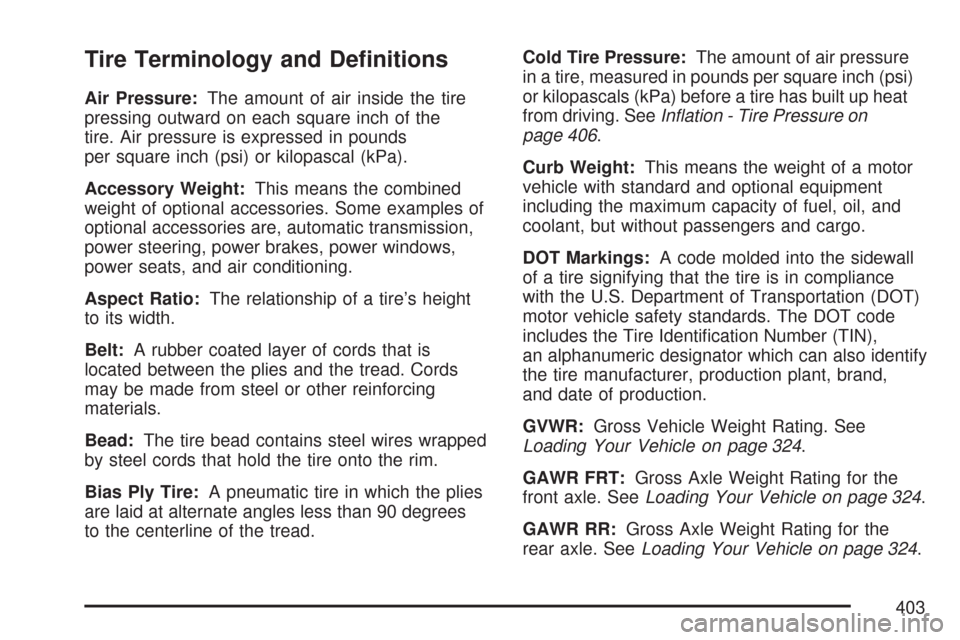
Tire Terminology and De�nitions
Air Pressure:The amount of air inside the tire
pressing outward on each square inch of the
tire. Air pressure is expressed in pounds
per square inch (psi) or kilopascal (kPa).
Accessory Weight:This means the combined
weight of optional accessories. Some examples of
optional accessories are, automatic transmission,
power steering, power brakes, power windows,
power seats, and air conditioning.
Aspect Ratio:The relationship of a tire’s height
to its width.
Belt:A rubber coated layer of cords that is
located between the plies and the tread. Cords
may be made from steel or other reinforcing
materials.
Bead:The tire bead contains steel wires wrapped
by steel cords that hold the tire onto the rim.
Bias Ply Tire:A pneumatic tire in which the plies
are laid at alternate angles less than 90 degrees
to the centerline of the tread.Cold Tire Pressure:The amount of air pressure
in a tire, measured in pounds per square inch (psi)
or kilopascals (kPa) before a tire has built up heat
from driving. SeeIn�ation - Tire Pressure on
page 406.
Curb Weight:This means the weight of a motor
vehicle with standard and optional equipment
including the maximum capacity of fuel, oil, and
coolant, but without passengers and cargo.
DOT Markings:A code molded into the sidewall
of a tire signifying that the tire is in compliance
with the U.S. Department of Transportation (DOT)
motor vehicle safety standards. The DOT code
includes the Tire Identi�cation Number (TIN),
an alphanumeric designator which can also identify
the tire manufacturer, production plant, brand,
and date of production.
GVWR:Gross Vehicle Weight Rating. See
Loading Your Vehicle on page 324.
GAWR FRT:Gross Axle Weight Rating for the
front axle. SeeLoading Your Vehicle on page 324.
GAWR RR:Gross Axle Weight Rating for the
rear axle. SeeLoading Your Vehicle on page 324.
403
Page 449 of 510
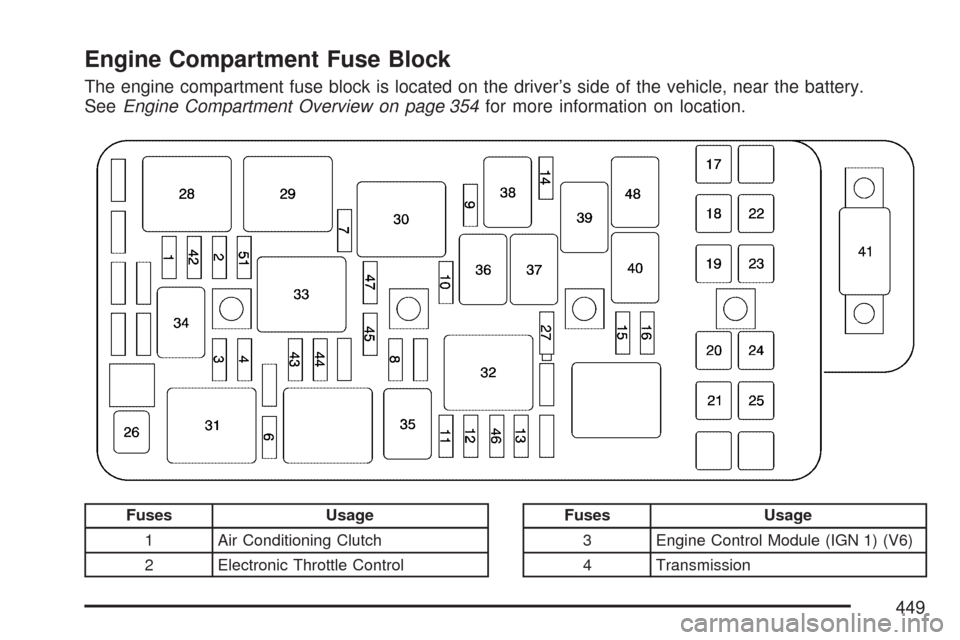
Engine Compartment Fuse Block
The engine compartment fuse block is located on the driver’s side of the vehicle, near the battery.
SeeEngine Compartment Overview on page 354for more information on location.
Fuses Usage
1 Air Conditioning Clutch
2 Electronic Throttle ControlFuses Usage
3 Engine Control Module (IGN 1) (V6)
4 Transmission
449
Page 451 of 510

Relays Usage
34 Air Conditioning Clutch
35 High-Beam Headlamps
36 Front Fog Lamps
37 Horn
38 Low-Beam Headlamps
39 Windshield Wiper 1
40 Windshield Wiper 2
48 Daytime Running LampsRear Compartment Fuse Block
The rear compartment fuse block is located in the
trunk of the vehicle. Access the fuse block
through the trunk panel on the driver’s side of the
rear cargo area.
451
Page 454 of 510
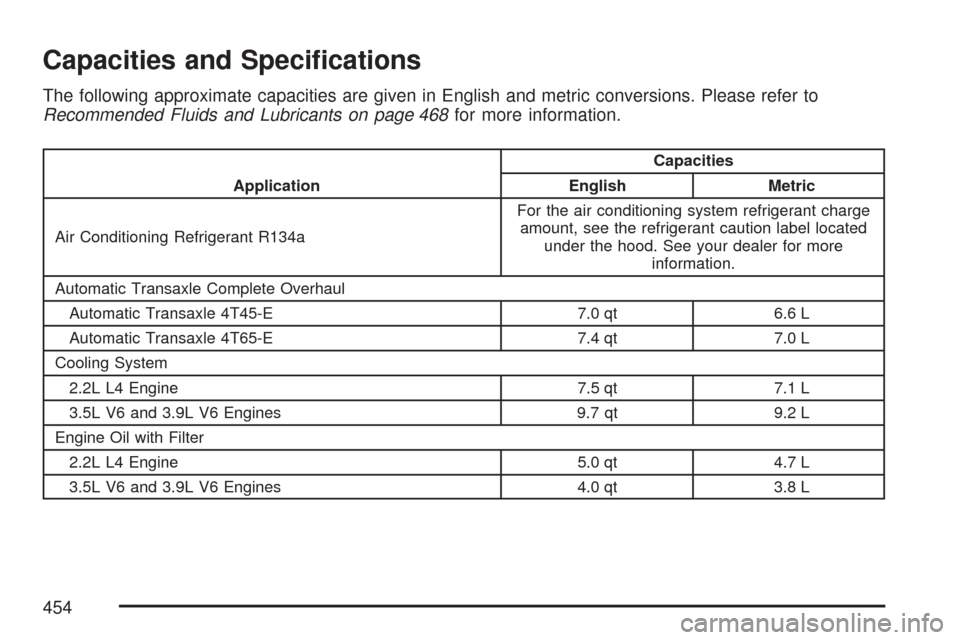
Capacities and Speci�cations
The following approximate capacities are given in English and metric conversions. Please refer to
Recommended Fluids and Lubricants on page 468for more information.
ApplicationCapacities
English Metric
Air Conditioning Refrigerant R134aFor the air conditioning system refrigerant charge
amount, see the refrigerant caution label located
under the hood. See your dealer for more
information.
Automatic Transaxle Complete Overhaul
Automatic Transaxle 4T45-E 7.0 qt 6.6 L
Automatic Transaxle 4T65-E 7.4 qt 7.0 L
Cooling System
2.2L L4 Engine 7.5 qt 7.1 L
3.5L V6 and 3.9L V6 Engines 9.7 qt 9.2 L
Engine Oil with Filter
2.2L L4 Engine 5.0 qt 4.7 L
3.5L V6 and 3.9L V6 Engines 4.0 qt 3.8 L
454
Page 463 of 510
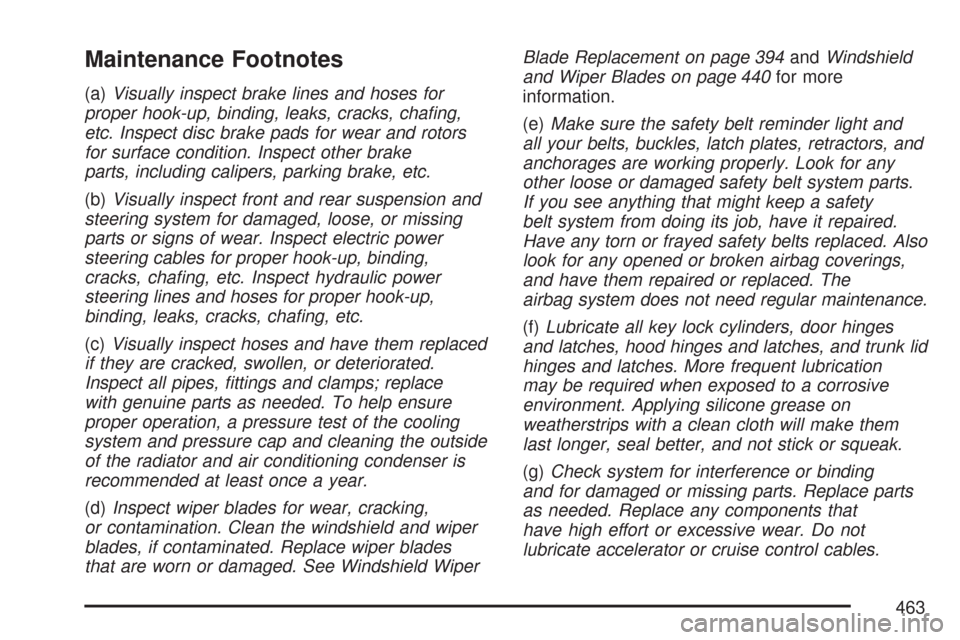
Maintenance Footnotes
(a)Visually inspect brake lines and hoses for
proper hook-up, binding, leaks, cracks, cha�ng,
etc. Inspect disc brake pads for wear and rotors
for surface condition. Inspect other brake
parts, including calipers, parking brake, etc.
(b)Visually inspect front and rear suspension and
steering system for damaged, loose, or missing
parts or signs of wear. Inspect electric power
steering cables for proper hook-up, binding,
cracks, cha�ng, etc. Inspect hydraulic power
steering lines and hoses for proper hook-up,
binding, leaks, cracks, cha�ng, etc.
(c)Visually inspect hoses and have them replaced
if they are cracked, swollen, or deteriorated.
Inspect all pipes, �ttings and clamps; replace
with genuine parts as needed. To help ensure
proper operation, a pressure test of the cooling
system and pressure cap and cleaning the outside
of the radiator and air conditioning condenser is
recommended at least once a year.
(d)Inspect wiper blades for wear, cracking,
or contamination. Clean the windshield and wiper
blades, if contaminated. Replace wiper blades
that are worn or damaged. See Windshield WiperBlade Replacement on page 394andWindshield
and Wiper Blades on page 440for more
information.
(e)Make sure the safety belt reminder light and
all your belts, buckles, latch plates, retractors, and
anchorages are working properly. Look for any
other loose or damaged safety belt system parts.
If you see anything that might keep a safety
belt system from doing its job, have it repaired.
Have any torn or frayed safety belts replaced. Also
look for any opened or broken airbag coverings,
and have them repaired or replaced. The
airbag system does not need regular maintenance.
(f)Lubricate all key lock cylinders, door hinges
and latches, hood hinges and latches, and trunk lid
hinges and latches. More frequent lubrication
may be required when exposed to a corrosive
environment. Applying silicone grease on
weatherstrips with a clean cloth will make them
last longer, seal better, and not stick or squeak.
(g)Check system for interference or binding
and for damaged or missing parts. Replace parts
as needed. Replace any components that
have high effort or excessive wear. Do not
lubricate accelerator or cruise control cables.
463
Page 495 of 510
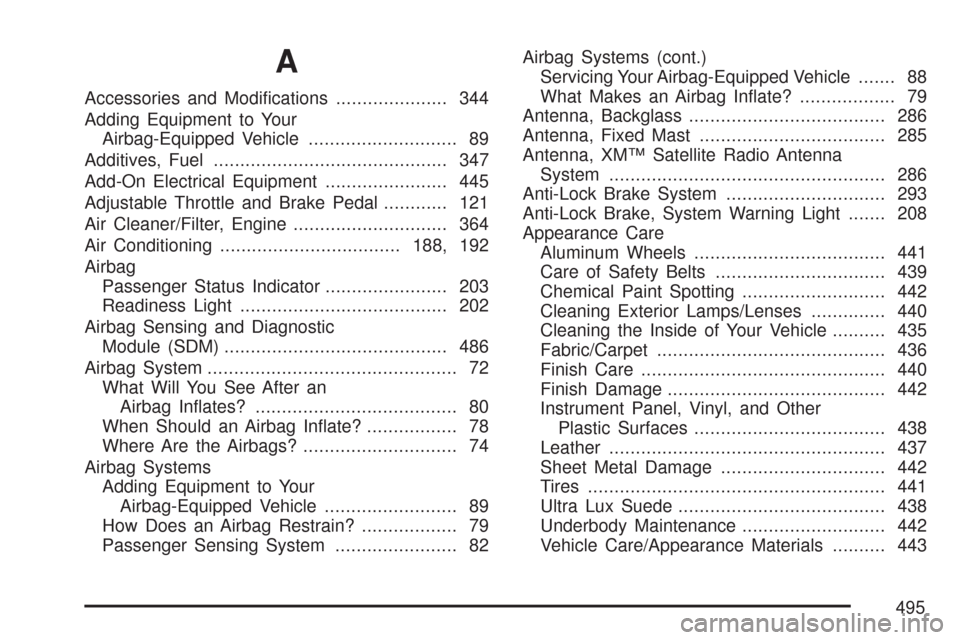
A
Accessories and Modi�cations..................... 344
Adding Equipment to Your
Airbag-Equipped Vehicle............................ 89
Additives, Fuel............................................ 347
Add-On Electrical Equipment....................... 445
Adjustable Throttle and Brake Pedal............ 121
Air Cleaner/Filter, Engine............................. 364
Air Conditioning..................................188, 192
Airbag
Passenger Status Indicator....................... 203
Readiness Light....................................... 202
Airbag Sensing and Diagnostic
Module (SDM).......................................... 486
Airbag System............................................... 72
What Will You See After an
Airbag In�ates?...................................... 80
When Should an Airbag In�ate?................. 78
Where Are the Airbags?............................. 74
Airbag Systems
Adding Equipment to Your
Airbag-Equipped Vehicle......................... 89
How Does an Airbag Restrain?.................. 79
Passenger Sensing System....................... 82Airbag Systems (cont.)
Servicing Your Airbag-Equipped Vehicle....... 88
What Makes an Airbag In�ate?.................. 79
Antenna, Backglass..................................... 286
Antenna, Fixed Mast................................... 285
Antenna, XM™ Satellite Radio Antenna
System.................................................... 286
Anti-Lock Brake System.............................. 293
Anti-Lock Brake, System Warning Light....... 208
Appearance Care
Aluminum Wheels.................................... 441
Care of Safety Belts................................ 439
Chemical Paint Spotting........................... 442
Cleaning Exterior Lamps/Lenses.............. 440
Cleaning the Inside of Your Vehicle.......... 435
Fabric/Carpet........................................... 436
Finish Care.............................................. 440
Finish Damage......................................... 442
Instrument Panel, Vinyl, and Other
Plastic Surfaces.................................... 438
Leather.................................................... 437
Sheet Metal Damage............................... 442
Tires........................................................ 441
Ultra Lux Suede....................................... 438
Underbody Maintenance........................... 442
Vehicle Care/Appearance Materials.......... 443
495